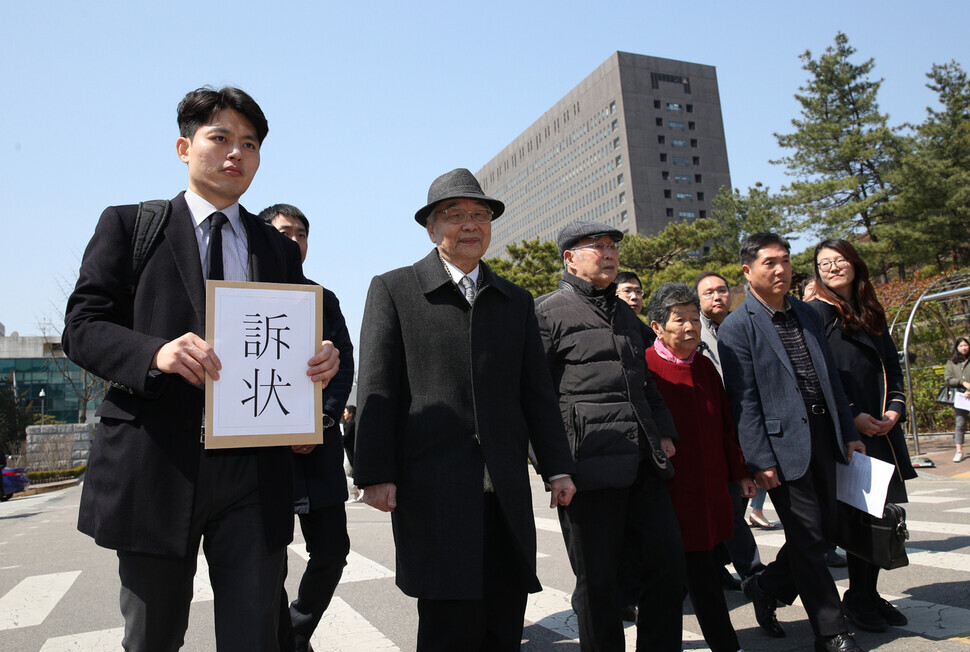hankyoreh
Links to other country sites 다른 나라 사이트 링크
Seoul Court rules against oldest surviving victim of Japan’s wartime forced labor

A centenarian survivor of forced labor mobilization during the Japanese occupation of Korea lost the first trial in his cases requesting damages from the Japanese companies that exploited him.
Survivors of Japan’s wartime slave labor have been suffering a string of losses in lower courts recently amid varying judgments on the statute of limitations for demanding damages.
On Wednesday morning, Judge Lee Baek-gyu of the Seoul Central District Court ruled against the plaintiff in a case filed by forced labor survivor Kim Han-su against Mitsubishi Heavy Industries.
Another case by a plaintiff identified by the surname Park — a surviving relative of another Korean forced to work in Japan — to demand damages from the construction company Kumagai Gumi was also dismissed.
The key issue in these suits by forced labor survivors has been the question of when the right to claim damages is first recognized. The civil code states that the right to claim damages “expires if the victim does not exercise their right to claim damages within three years of the date on which they suffered the damages or became aware of the perpetrator.”
Forced labor survivors also filed suit in 2005 to claim damages from Nippon Steel, but lost their case in a lower court. But in 2012, the Supreme Court remanded the case for a ruling in favor of the plaintiffs, who eventually won in an en banc Supreme Court ruling in 2018.
In response, the victims have been claiming that the statute of limitations began counting down on Oct. 30, 2018, when the Supreme Court’s final en banc ruling was issued.
Meanwhile, the Japanese businesses have countered that the start date should be regarded as May 24, 2012, when the Supreme Court issued its remand and reversal ruling.
This has led to differences in the rulings by lower courts.
In December 2018, the Gwangju High Court sided with the plaintiff in its ruling, determining that the start date for the right to claim damages came with that year’s en banc ruling by the Supreme Court.
But in August and September 2021, Judge Park Seong-in of the Seoul Central District Court sided with the Japanese companies, concluding that the statute of limitations began counting down with the Supreme Court’s remand and reversal judgment in 2012. Similarly, presiding Judge Park Jin-su of the Seoul Central District Court also accepted the Japanese company’s argument in a ruling against the surviving family members of a forced labor victim earlier this month.
In its recent rulings against Kim and Park, the court appears to have regarded 2012 as the date when the statute of limitations began counting down and declined to recognize their right to claim damages on that basis.
Kim was sent to Nagasaki during Japan’s wartime mobilization in 1944. He worked at a Mitsubishi shipyard there and suffered radiation exposure after the US’ 1945 atomic bombing of the city before returning to South Korea. He filed his suit claiming damages from Mitsubishi in April 2019.
Meeting with reporters shortly after the ruling, Kim’s attorney Kim Sung-ju called the court’s judgment “dismaying.”
“Before the Supreme Court’s final ruling in 2018, it had not even been legally established whether victims were able to demand compensation from Japanese companies,” he explained.
“Since most of the victims were elderly or had already passed away, they were unable to even make the decision as to whether to fight for their rights,” he added, noting that he intended to “receive another judgment in the appellate trial on issues such as the statute of limitations.”
By Choi Min-young, staff reporter
Please direct questions or comments to [english@hani.co.kr]

Editorial・opinion
![[Column] The state is back — but is it in business? [Column] The state is back — but is it in business?](https://flexible.img.hani.co.kr/flexible/normal/500/300/imgdb/original/2024/0506/8217149564092725.jpg) [Column] The state is back — but is it in business?
[Column] The state is back — but is it in business?![[Column] Life on our Trisolaris [Column] Life on our Trisolaris](https://flexible.img.hani.co.kr/flexible/normal/500/300/imgdb/original/2024/0505/4817148682278544.jpg) [Column] Life on our Trisolaris
[Column] Life on our Trisolaris- [Editorial] Penalties for airing allegations against Korea’s first lady endanger free press
- [Editorial] Yoon must halt procurement of SM-3 interceptor missiles
- [Guest essay] Maybe Korea’s rapid population decline is an opportunity, not a crisis
- [Column] Can Yoon steer diplomacy with Russia, China back on track?
- [Column] Season 2 of special prosecutor probe may be coming to Korea soon
- [Column] Park Geun-hye déjà vu in Yoon Suk-yeol
- [Editorial] New weight of N. Korea’s nuclear threats makes dialogue all the more urgent
- [Guest essay] The real reason Korea’s new right wants to dub Rhee a founding father
Most viewed articles
- 1[Column] Why Korea’s hard right is fated to lose
- 2Amid US-China clash, Korea must remember its failures in the 19th century, advises scholar
- 3[Column] The state is back — but is it in business?
- 4[Column] Life on our Trisolaris
- 5AI is catching up with humans at a ‘shocking’ rate
- 6[Guest essay] Maybe Korea’s rapid population decline is an opportunity, not a crisis
- 7[Column] Can Yoon steer diplomacy with Russia, China back on track?
- 860% of young Koreans see no need to have kids after marriage
- 9[Reporter’s notebook] In Min’s world, she’s the artist — and NewJeans is her art
- 10[Editorial] Penalties for airing allegations against Korea’s first lady endanger free press